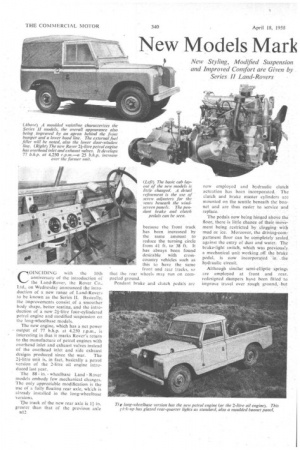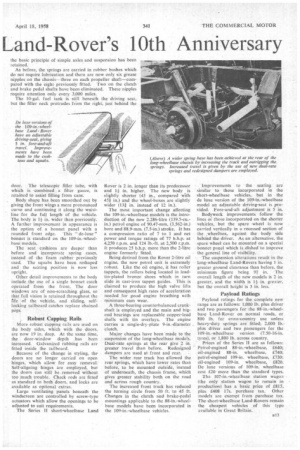New Models Mark Land-Rover's 10th Anniversary
Page 46

Page 47

If you've noticed an error in this article please click here to report it so we can fix it.
COINCIDING with the 10th anniversary of the introduction of the Land-Rover, the Rover Co., Ltd., on Wednesday announced the introduction of a new range of Land-Rovers to be known as the Series 11. Basically, the improvements consist of a smoother body shape, better seating, and the introduction of a new 21-litre four-cylindered petrol engine and modified suspension on the long-wheelbase models.
The new engine, which has a net power output of 77 b.h.p. at 4,250 r.p.m., is interesting in that it marks Rover's return to the manufacture of petrol engines with overhead inlet and exhaust valves instead of the overhead inlet and side exhaust designs produced since the war. The 21-litre unit is, in fact, basically a petrol version of the 2-litre oil engine introduced last year.
The 88 in. wheelbase Land Rover models embody few mechanical changes. The only appreciable modification is the use of a fully floating rear axle, which is already installed in the long-wheelbase versions.
Tfie track of the new rear axle is LI in. greater than that of the previous axle n12
because the front track has been increased by the same amount to reduce the turning circle from 41 ft. to 38 ft. It has always been found desirable with crosscountry vehicles such as this to have the same front and rear tracks, so that the rear wheels may run on compacted ground.
Pendant brake and clutch pedals arc now employed and hydraulic clutch actuation has been incorporated. The clutch and brake master cylinders are mounted on the scuttle beneath the bonnet and are thus easier to service and replace.
The pedals now being hinged above the floor, there is little chance of their movement being restricted by clogging with mud or ice. Moreover, the driving-compartment floor can be completely sealed against the entry of dust and water. The brake-light switch, which was previously a mechanical unit working .off the brake pedal, is now incorporated in .ti..;e hydraulic circuit.
Although similar semi-elliptic springs are employed at front and rear, redesigned dampers have been fitted to improve travel over rough ground, but the basic principle of simple axles and suspension has been retained, As before, the springs are carried in rubber bushes which do not require lubrication and there are now only six grease nipples on the chassis--three on each propeller shaft—compared with the eight previously fitted. Two on the clutch and brake pedal shafts have been eliminated. These nipples require attention only every 3,000 miles.
The 10-gal. fuel tank is still beneath the driving seat, but the filler neck protrudes from the right, just behind the door, The telescopic filler tube, with
which is combined a filter gauze, is retained to assist filling from cans-.
Body shape has been smoothed out by giving the front wings a more pronounced curve and continuing it alongthe waistline for the full length of the vehicle. The body is l in. wider than previously. A further improvement in appearance is the option of a bonnet panel with a
rounded front edge. This " de-luxe " bonnet is standard on the 109-in.-wheelbase models.
The scat cushions are deeper than before and incorporate spring cases, instead of the foam rubber previously used. The squabs have been reshaped and the seating position is now less upright.
Other detail improvements to the body include the use of a single bonnet catch operated from the front. The door windows are of non-scratching glass, so that full vision is retained throughout the rife of the vehicle, and sliding, selflocking tailboard catches replace chained pegs . Robust Capping Rails
More robust capping rails are used on the body sides, which with the doors, are now 19 in. deep. At the same time, the door-window depth has been increased. Galvanized rubbing rails are fitted inside the tailboard.
Because of the change in styling, the doors are no longer carried on open hinges, which allow for easy removal. Self-aligning hinges are employed, but the doors can still be removed without too much trouble. Check rods are fitted as standard to both doors, and locks are available as optional extras.
Large ventilating panels beneath the windscreen are controlled by screw-type actuators which allow the openings to be adjusted to suit requirements.
The Series H short-wheelbase Land Rover is 2 in, longer than its predecessor and l in. higher. The new body is slightly shorter .(43 in., compared with 451 in.) and the wheel-boxes are slightly wider On in. instead of 12 in.).
The most important change affecting the 109-in.-wheeibase models is the introduction of the new 2.286-litre (139.5-cu.in.) petrol engine of 90.47-mm. (3.562-in.) bore and 88.9-mm. (7.5-in.) stroke. It has a compression ratio of 7 to 1 and net power and torque ratings of 77 b.h.p. at 4,250 r.p.m. and 124 lb.-ft. at 2,500 r.p.m. It produces 25 b.h.p, more than the 2-litre engine formerly fitted.
Being derived from the Rover 2-litre oil engine, the new petrol unit is extremely robust. Like the oil engine, it has roller tappets, the rollers being located in leadtin-plated bronze shoes which in turn slide in cast-iron tappet guides. This is claimed to produce the high valve lifts and consequent high rates of acceleration needed for good engine breathing with minimum cam wear.
A three-bearing counterbalanced crankshaft is employed and the main and bigend bearings are replaceable copper-lead shells with tin overlays. The engine carries a single-dry-plate 9-in.-diameter clutch.
Major changes have been made to the suspension of the long-wheelbase models. Dual-rate springs at the rear give 2 in. greater travel than before. Redesigned dampers are used at front and rear. • The wider rear track has allowed the rear springs, which have lower rates than before, to be mounted Outside, instead of underneath, the chassis frame, which gives greater stability both on the road and across rough country.
The increased front track has reduced the turning circle from 50 ft. to 45 ft. Changes in the clutch and brake-pedal mountings applicable to the 88-in.-wheelbase models have been incorporated in the 109-in.-wheelbase vehicles.
Improvements to the seating are similar to those incorporated in the short-wheelbase vehicles, but in the -de luxe version of the 109-in.-wheelbase model an adjustable driving-seat is provided. Fore-and-aft adjustment is 5 in.
Bodywork improvements follow the lines ot those incorporated on the shorter vehicles, but the spare -wheel is now carried vertically in a recessed section of the wheelbox, against the body side behind the driver. As an alternative, the spare wheel can be mounted on a special • bonnet panel which is dished to improve the general line of visibility.
The suspension alterations result in the long-wheelbase Land-Rovers having 1 in. greater ground clearance than before, the minimum figure being 9.1 in. The overall length of the new models is 2 in.
greater, and the width is in. greater, but the overall height is 3 in. less.
Payload Ratings
Payload ratings for the complete new range are as follows: 1.000 lb. plus driver and two passengers for the 88-in.-wheelbase Land-Rover on normal roads, or 800 lb. for cross-country use unless heavy-duty springs are fitted; 2,000 lb. plus driver and two passengers for the 109-in.-wheelbase version (7.50-16-in. tyres), or 1,800 lb. across country.
Prices of the Series II are as follows: Petrol-engined 88-in.-wheelbase, £640; oil-engined 88-in. wheelbase, £740; petrol-engined 109-in. wheelbase, €730; oil-engined I09-in. wheelbase, £820. De luxe versions of 109-in, wheelbase cost 120 more than the standard types.
The 107-in.-wheelbase station wagon (the only station wagon to remain in production) has a basic price of £815, plus £408 17s. purchase tax. Other models are exempt from purchase tax. The short-wheelbase Land-Rovers remain the cheapest vehicles of this type available in Great Britain.








































































































